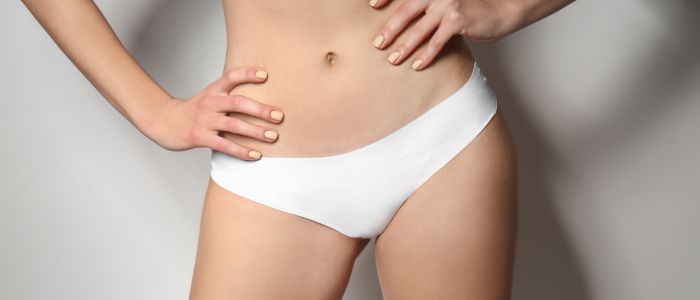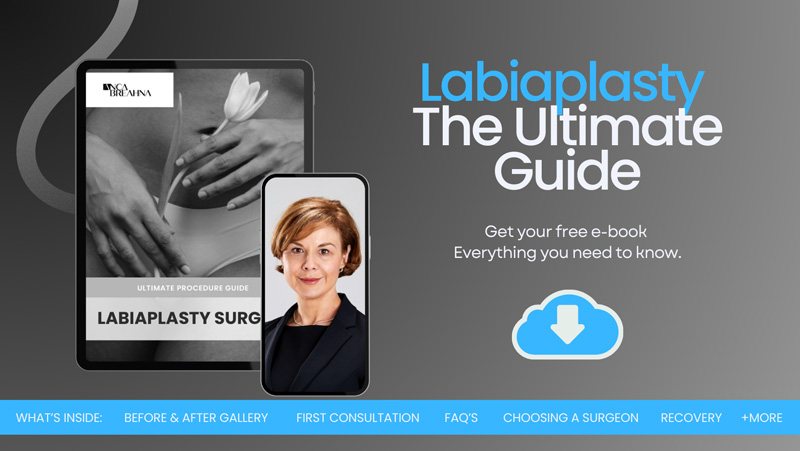
Table of Contents
- Differences between Trim, Wedge, and Hybrid Labiaplasty Procedures
- Download the Labiaplasty Guide
- Trim Labiaplasty
- How Trim Labiaplasty is Performed
- Benefits of Trim Labiaplasty
- Ideal Candidates for Trim Labiaplasty
- Recovery Process and Care after Trim Labiaplasty
- Potential Risks and Complications
- Wedge Labiaplasty
- How Wedge Labiaplasty is Performed
- Benefits of Wedge Labiaplasty
- Ideal Candidates for Wedge Labiaplasty
- Recovery Process and Care After Wedge Labiaplasty
- Potential Risks and Complications
- Hybrid Labiaplasty
- How Hybrid Labiaplasty is Performed
- Benefits of Hybrid Labiaplasty
- Ideal Candidates for Hybrid Labiaplasty
- Recovery Process and Care After Hybrid Labiaplasty
- Potential Risks and Complications
- Comparing Labiaplasty Types
- Trim Labiaplasty: Key Features and Suitability
- Wedge Labiaplasty: Key Features and Suitability
- Hybrid Labiaplasty: Key Features and Suitability
- Factors to Consider when Choosing a Labiaplasty Type
- FAQs about Labiaplasty Types – Trim Labiaplasty and Wedge Labiaplasty or Hybrid
- Further Reading about Labiaplasty with Consultant Plastic Surgeon Anca Breahna
Differences between Trim, Wedge, and Hybrid Labiaplasty Procedures
Labiaplasty is a surgical procedure often considered by women seeking to change the appearance or address discomfort resulting from the size or shape of their labia. The reasons for opting for labiaplasty are varied and can include physical discomfort during physical activities, clothing discomfort, or a desire for a change in appearance.
The procedure itself can be performed using different techniques, the most common being the Trim Labiaplasty, Wedge Labiaplasty, and Hybrid Labiaplasty. Each of these methods has distinct approaches to reshaping the labia, tailored to meet the specific desires or needs of the patient.
In this blog, Chester Consultant Plastic Surgeon Anca Breahna will discuss the details of each type of labiaplasty – trim labiaplasty and wedge labiaplasty.
Download the Labiaplasty Guide

Trim Labiaplasty
The Trim Labiaplasty procedure involves the direct removal of excess labial tissue along the edge of the labia minora. The goal is to reduce the size of the labia minora so that it no longer protrudes beyond the labia majora. This technique is straightforward and can be precisely tailored to the amount of reduction desired by the patient.
How Trim Labiaplasty is Performed
Performed under local anaesthesia with sedation or general anaesthesia, Trim Labiaplasty begins with marking the excess labial tissue to be removed. Anca then carefully trims the marked tissue, ensuring to maintain symmetry and natural contours. The incision is closed with dissolvable stitches, which minimises scarring and promotes a natural-looking result. The procedure typically takes about one to two hours, depending on the extent of the tissue removal.
Benefits of Trim Labiaplasty
Patients who undergo Trim Labiaplasty often report an immediate improvement in physical comfort, particularly in activities that previously caused irritation or discomfort. Additionally, many find that clothing fits more comfortably without the labial tissue causing bulging or chafing. From an aesthetic perspective, the procedure can achieve a significant change in the labia’s appearance, aligning it more closely with the patient’s desires.
Ideal Candidates for Trim Labiaplasty
Good candidates for Trim Labiaplasty are women who experience discomfort due to the size of their labia minora, have concerns about the appearance of their labia, or both. Candidates should be in good overall health, have realistic expectations about the outcomes, and understand the potential risks and recovery process.
Recovery Process and Care after Trim Labiaplasty
The recovery period following Trim Labiaplasty generally involves a few days of rest and limited activity to facilitate healing. You may experience swelling and discomfort, which can be managed with prescribed medication. Following Anca’s post-operative care instructions is crucial for a smooth recovery and optimal results. Most patients can return to work and normal activities within a week, though strenuous activities and sexual intercourse should be avoided for approximately 4-6 weeks.
Potential Risks and Complications
As with any surgical procedure, Trim Labiaplasty carries potential risks, including bleeding, infection, asymmetry, and changes in sensation.
Wedge Labiaplasty
Wedge Labiaplasty represents an alternative surgical approach to modifying the labia minora, focusing on maintaining the natural edge of the labia while reducing its overall size. This technique is particularly beneficial for individuals who seek a more conservative reduction or wish to preserve the labia’s natural contour.
Unlike Trim Labiaplasty, which involves removing excess tissue along the edge of the labia minora, Wedge Labiaplasty removes a wedge-shaped portion of tissue from the labia. This method allows for the preservation of the labia minora’s natural border. The primary aim is to reduce the volume of the labia minora without altering its original contour significantly.
How Wedge Labiaplasty is Performed
Wedge Labiaplasty is typically performed under local anaesthesia with sedation or under general anaesthesia. The procedure starts with Anca marking a wedge-shaped section of the labia minora for removal. This section is carefully excised, and the remaining edges are sutured together, reducing the labia’s size while maintaining its natural edge. The surgery usually lasts between one to two hours, depending on the complexity and the extent of the tissue removal.
Benefits of Wedge Labiaplasty
One of the primary benefits of Wedge Labiaplasty is its ability to maintain the natural appearance of the labia minora’s edge, which is a significant consideration for many women. This technique also allows for a reduction in size while preserving the labial tissue’s original colour and texture. Patients often report enhanced comfort in daily activities and personal attire post-surgery. Furthermore, the preservation of the natural labial edge can be aesthetically pleasing for those who value a less altered appearance.
Ideal Candidates for Wedge Labiaplasty
Good candidates for Wedge Labiaplasty are women who are concerned about the size of their labia minora but wish to retain the natural edge and look of their labia. They should be in good general health, have realistic expectations of the surgical outcomes, and understand the recovery process and potential risks.
Recovery Process and Care After Wedge Labiaplasty
The recovery period for Wedge Labiaplasty involves several days of rest with limited physical activity. Swelling and discomfort may occur but can be managed with medication as prescribed by Anca. Adherence to post-operative instructions is important for a smooth recovery and achieving the desired results. Most patients can resume work and normal activities within a week, though it is advisable to avoid strenuous activities and sexual intercourse for approximately 4-6 weeks.
Potential Risks and Complications
While Wedge Labiaplasty is generally safe, it carries potential risks such as bleeding, infection, asymmetry, and changes in sensation. There may also be a risk of wound separation, given the nature of the wedge removal and suturing technique.
Hybrid Labiaplasty
Hybrid Labiaplasty combines elements of both the Trim and Wedge techniques, offering a tailored approach to labia minora reduction. This method is designed to address unique anatomical considerations and specific aesthetic desires, providing a customised solution for women whose needs may not be fully met by either the Trim or Wedge procedure alone.
Hybrid Labiaplasty is a versatile procedure that allows Anca to adapt her surgical approach based on your unique anatomy and desired outcome. By incorporating aspects of both the Trim and Wedge methods, Anca can achieve a reduction in size, maintain the natural border of the labia minora, and address any asymmetries or specific concerns. This technique offers a comprehensive approach to labiaplasty, ensuring that the final result aligns closely with your expectations.
How Hybrid Labiaplasty is Performed
The Hybrid Labiaplasty procedure is performed under local anaesthesia with sedation or general anaesthesia, based on the extent of the surgery and your comfort. Anca will devise a custom surgical plan that may involve trimming excess tissue along the edge of the labia minora and removing a wedge-shaped portion of tissue to achieve the desired contour and symmetry. The incisions are then carefully sutured to ensure minimal scarring and a natural-looking outcome. The duration of the surgery varies depending on the complexity of the case but generally falls within one to two hours.
Benefits of Hybrid Labiaplasty
The primary advantage of Hybrid Labiaplasty lies in its customisability, allowing for precise adjustments to the labia’s size, shape, and symmetry. This tailored approach can address a wider range of concerns, including asymmetry, excessive protrusion, and specific aesthetic preferences. Patients often report improved comfort in daily activities and attire, as well as satisfaction with the aesthetic appearance of their labia. The Hybrid technique also facilitates the preservation of the labia’s natural colour and texture while achieving the desired reduction.
Ideal Candidates for Hybrid Labiaplasty
Ideal candidates for Hybrid Labiaplasty include women with specific or complex concerns regarding their labia minora that cannot be adequately addressed by either the Trim or Wedge method alone. Suitable candidates are in good general health, have realistic expectations regarding the surgery’s outcomes, and are seeking a customised solution for labia reduction.
Recovery Process and Care After Hybrid Labiaplasty
Recovery from Hybrid Labiaplasty involves a short period of rest and limited activity, with most patients able to return to work and normal activities within a week. Swelling and discomfort are common but can be managed with prescribed medication. Following Anca’s post-operative care instructions is critical for a smooth recovery and optimal results. Strenuous activities and sexual intercourse should be avoided for approximately 4-6 weeks to allow for proper healing.
Potential Risks and Complications
As with any surgical procedure, Hybrid Labiaplasty carries potential risks, including bleeding, infection, asymmetry, and changes in sensation.
Comparing Labiaplasty Types
When considering labiaplasty, understanding the distinctions between the Trim, Wedge, and Hybrid techniques is important for making an informed decision that aligns with your individual needs and preferences. Each method offers unique advantages and is suited to different anatomical considerations and aesthetic goals.
Trim Labiaplasty: Key Features and Suitability
Trim Labiaplasty is characterised by the direct removal of excess tissue along the edge of the labia minora, making it a suitable option for individuals looking to address elongated labia that may cause discomfort or dissatisfaction with their appearance. This method is straightforward and offers a clear solution for reducing the size of the labia minora, ensuring they no longer protrude beyond the labia majora. It is ideal for those who prioritise a significant reduction in size and are less concerned about maintaining the natural edge of the labia.
Wedge Labiaplasty: Key Features and Suitability
Wedge Labiaplasty focuses on preserving the natural border of the labia minora while achieving a reduction in size. By removing a wedge-shaped section of tissue, this technique maintains the labia’s natural contour and texture. It is particularly well-suited for individuals who desire a moderate reduction and value the preservation of the labia minora’s natural appearance. The Wedge method is recommended for those concerned about maintaining the integrity of the labial edge and who may have less extensive tissue protrusion.
Hybrid Labiaplasty: Key Features and Suitability
Hybrid Labiaplasty offers a customisable approach, combining elements of both Trim and Wedge techniques to address a broader range of anatomical and aesthetic concerns. This method is adaptable and can be tailored to achieve precise adjustments to the labia’s size, shape, and symmetry. Hybrid Labiaplasty is ideal for women with complex or specific concerns that cannot be fully addressed by the Trim or Wedge method alone. It caters to those seeking a bespoke solution that accommodates unique anatomical variations and preferences.
Factors to Consider when Choosing a Labiaplasty Type
Deciding between the Trim, Wedge, or Hybrid Labiaplasty techniques involves considering several factors, including your primary concerns (whether they are functional, aesthetic, or both), your anatomical structure, and your desired outcome. Discussing these aspects thoroughly with Anca is essential. Anca’s expertise and understanding of your goals will guide the recommendation for the most appropriate technique to achieve the desired results.
FAQs about Labiaplasty Types – Trim Labiaplasty and Wedge Labiaplasty or Hybrid

How do I decide between Trim, Wedge, and Hybrid Labiaplasty if I’m concerned about recovery time?
The choice between these techniques should not be solely based on recovery time, as the difference is often minimal. The focus should be on the specific outcomes each method offers and how they align with your anatomical needs and aesthetic goals. However, discussing recovery expectations with Anca can provide clarity, as personal healing rates and the complexity of the procedure may influence recovery time.
Can Labiaplasty techniques be customised if I have unique anatomical features?
Yes, Labiaplasty, especially the Hybrid technique, offers a high degree of customisation to accommodate unique anatomical features. Anca can tailor the procedure, combining elements of the Trim and Wedge methods, to address specific concerns such as asymmetry, varying tissue excess, or a desire to preserve the natural edge of the labia while achieving a reduction.
Is it possible to switch from one Labiaplasty technique to another if I’m not satisfied with the results?
Revision surgery is possible but requires careful consideration and should only be pursued after a thorough consultation with a skilled surgeon. The feasibility of switching techniques depends on the amount of tissue remaining and the specific concerns to be addressed. Revision surgery carries its own risks and challenges, making it essential to have clear communication and realistic expectations from the outset.
How do Labiaplasty techniques affect long-term sensitivity and sexual function?
All Labiaplasty techniques aim to preserve or enhance sexual function, with no intended impact on long-term sensitivity. Changes in sensitivity immediately following the surgery are typically temporary. A skilled surgeon will take care to avoid nerves that could affect sensitivity. Discussing these concerns pre-operatively with your surgeon can provide reassurance.
Are the results of Trim, Wedge, and Hybrid Labiaplasty permanent?
The results of Labiaplasty are generally considered permanent. However, it’s important to note that natural changes due to ageing, hormonal fluctuations, or significant life events like childbirth can affect the labia’s appearance over time.
Medical References about Labiaplasty Types
- Labiaplasty (vulval surgery) – NHS: https://www.nhs.uk/tests-and-treatments/cosmetic-procedures/cosmetic-surgery/labiaplasty/
- Labiaplasty | Aesthetic Genital Plastic Surgery – ASPS: https://www.plasticsurgery.org/cosmetic-procedures/aesthetic-genital-plastic-surgery/labiaplasty
- Labiaplasty Minora Reduction – NCBI: https://www.ncbi.nlm.nih.gov/books/NBK563199/
- Labiaplasty: Surgery, Recovery & What To Expect – Cleveland Clinic: https://my.clevelandclinic.org/health/treatments/21953-labiaplasty
- Vaginal Plastic Surgery: Vaginoplasty and Labiaplasty – WebMD: https://www.webmd.com/women/vaginal-plastic-surgery
Further Reading about Labiaplasty with Consultant Plastic Surgeon Anca Breahna
- Read more about Wedge Technique for Labia Minora Reduction
- Read more about Labiaplasty vs Vaginoplasty
- Read more about Scars after Labiaplasty
- Read more about Recovery after Labiaplasty
- Read more about What Are the Trim and Wedge Methods for Labiaplasty Surgery?
- Read more about Exercise after Labiaplasty
- Read more about Treatments and Solutions for Enlarged Labia
- Read more about 10 Questions to Ask Your Surgeon before Labiaplasty Surgery








